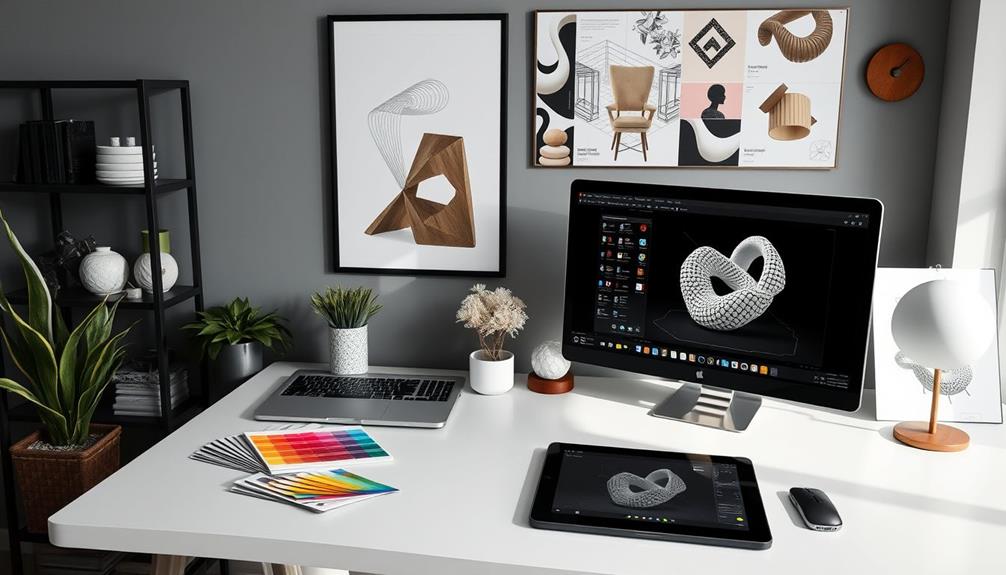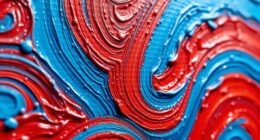To market your interior design business effectively, start by optimizing your Google My Business listing for better local visibility. Incorporate stunning visual content on platforms like Instagram and Pinterest, showcasing your best work to attract clients. Develop a strong portfolio that highlights diverse styles and engage with clients through interactive content. Don't forget to leverage referral programs and network with industry professionals to expand your reach. Consistent content marketing helps establish your expertise, while analytics tools keep your strategies on track. There's so much more to explore to elevate your marketing game and attract more clients. Furthermore, understanding and finding your ideal interior design clients is crucial for targeted marketing efforts. Research your target demographic to tailor your messaging and services to their specific needs and preferences. Utilize social media and email marketing to build relationships with potential clients and nurture leads through personalized communication. By consistently refining your marketing approach and staying attuned to your ideal clients, you can position your interior design business for sustained success.
Key Takeaways
- Optimize your Google My Business listing with complete information and regular updates to enhance local visibility and credibility.
- Utilize high-quality visual content on social media platforms like Instagram and Pinterest to showcase your design work and engage potential clients.
- Develop a strong portfolio featuring diverse styles and photorealistic designs to attract clients and increase conversion rates.
- Network with local realtors, contractors, and industry professionals to expand service offerings and enhance referral opportunities.
- Implement a content marketing strategy through SEO-friendly blog posts and downloadable resources to establish authority and drive traffic to your website.
Google My Business Optimization

Optimizing your Google My Business (GMB) profile is essential for boosting your interior design business's local visibility. A well-maintained GMB listing can considerably enhance your online presence and improve your local SEO. Did you know that 5% of views on a GMB listing lead to actions like calls, direction requests, or website visits?
Completing all fields—like hours, descriptions, website links, and social media links—can make your business more credible and searchable. Additionally, incorporating elements of a healthy lifestyle into your design philosophy can attract clients who value well-being in their living spaces.
Regularly posting updates and photos of your completed projects keeps your listing active and engages potential clients. When prospective clients see your recent work, it not only showcases your skills but also builds trust.
Furthermore, encouraging satisfied clients to leave reviews on your GMB listing can further boost your online reputation. With 72% of consumers reading reviews before choosing a business, positive feedback can help you generate new leads.
Visual Marketing Strategies

When it comes to visual marketing strategies, you can greatly boost your interior design business by utilizing photorealistic designs to captivate clients.
Engaging on social media platforms like Instagram and Pinterest helps you share stunning project visuals and inspiration, enhancing your brand's visibility.
Photorealistic Design Utilization
Harnessing the power of photorealistic design can transform how you market your interior design business. By utilizing photorealistic designs, you can create stunning visual content that resonates with potential clients, helping them visualize uncompleted projects and emotionally connect with your design vision. This connection increases the likelihood of closing deals.
Incorporating elements of modern farmhouse bedrooms or unique living room transformations can further illustrate your design capabilities and attract diverse clientele. Tools like Cedreo allow you to produce high-quality images quickly, cutting down on revisions and enhancing communication regarding project expectations.
Remember, around 72% of consumers are more likely to engage with businesses that showcase high-quality visual content. This statistic underscores the importance of integrating photorealistic designs into your marketing strategies to attract new clients.
In a competitive market, incorporating these visuals into your marketing materials not only showcases your skills but also sets you apart from the crowd. Regularly sharing photorealistic designs on platforms like Instagram and Pinterest can considerably boost audience engagement, as these platforms thrive on visually appealing content.
This approach can effectively increase your visibility and help generate leads, ensuring your interior design business stands out in a crowded marketplace.
Social Media Engagement
Social media engagement is essential for effectively marketing your interior design business, allowing you to showcase your work and connect with potential clients. Utilizing platforms like Instagram and Pinterest, you can share engaging visuals that highlight your projects, driving traffic to your portfolio and generating leads.
With over 1 billion active users on Instagram, using effective hashtags can greatly increase your visibility. To foster a deeper connection with your audience, consider incorporating elements that encourage reviving old friendships through shared design experiences or community projects.
Create visually appealing content that captures your design style and engages your audience. Regularly post behind-the-scenes content and client testimonials to foster interaction and build trust with your followers. Authentic connections are key to maintaining interest and loyalty.
Don't forget to leverage interactive content on social media platforms, such as polls and Q&A sessions, to encourage community engagement. This approach keeps your brand consistent while expanding your reach to new potential clients.
Pinterest for Inspiration
Often overlooked, Pinterest serves as an essential tool for interior designers looking to inspire and attract clients. With over 450 million active users seeking creative ideas, it's a prime space to showcase your skills and design projects.
Start by creating themed boards that categorize your work, making it easy for users to navigate through your design ideas. This not only enhances visibility but also optimizes your content through effective keyword strategies.
High-quality images of completed projects are key; nearly 90% of Pinterest users utilize the platform to plan purchases or projects. By pinning these images, you can drive notable traffic to your website.
Engage with the Pinterest community by repinning relevant content and following other users. This interaction increases your visibility and helps you connect with potential clients.
Don't forget to utilize Pinterest's rich pins feature, which provides more context about your ideas. This can enhance user engagement and encourage sharing, promoting your design work further.
Incorporating these marketing strategies for interior design on Pinterest can notably elevate your brand and lead to new opportunities.
Portfolio Development

A strong portfolio is vital for showcasing your interior design skills and attracting potential clients. Focus on portfolio development by including high-quality images and videos of your completed projects. This allows potential clients to see your design abilities and the diverse styles you offer.
Utilizing photorealistic designs in your portfolio can enhance client understanding and emotional engagement, making them 70% more likely to close deals when they can visualize the final outcome. Additionally, incorporating insights from innovative architectural solutions can further elevate your portfolio's appeal, demonstrating a thorough understanding of space and design.
Diversifying your portfolio with various design styles and scales not only attracts a wider audience but also demonstrates your adaptability and expertise in meeting different client preferences.
Additionally, consider incorporating interactive elements, such as virtual tours or 3D walkthroughs, which can greatly increase client engagement. These immersive experiences build trust in your design vision and create a lasting impression.
Regularly updating your portfolio with recent projects is essential. Sharing your work on social media platforms like Instagram and Pinterest can boost visibility and drive traffic to your main portfolio website.
This approach enhances your overall marketing strategies and helps establish your brand in the competitive interior design market. Keep your portfolio fresh, engaging, and reflective of your unique style.
Advertising and Direct Marketing

Effective advertising and direct marketing can make or break your interior design business. To attract clients and grow your brand, you need to implement smart marketing strategies.
Start by utilizing Google Ads to target service-based keywords with location specifics, maximizing your return on investment. Additionally, consider leveraging social media platforms to engage directly with your target audience, fostering real-time interactions that can enhance brand awareness.
Consider incorporating direct mail into your approach. It's a viable strategy that allows you to reach a broad audience. Make your direct mail stand out with eye-catching project photos and clear value propositions. Personalization is key—it resonates with potential clients and boosts engagement.
Here are some effective strategies to enhance your advertising efforts:
- Combine digital marketing with traditional methods: Align your ads with local events to reinforce your community presence.
- Craft attractive direct mail offers: Guarantee they communicate value and encourage responses from specific demographics.
- Track and analyze your campaigns: This helps optimize your spend and improve future efforts, guaranteeing maximum effectiveness and reach.
Networking and Community Building

Building a strong network is essential for the success of your interior design business. By networking with realtors, contractors, and architects, you can notably expand your service offerings and tap into collaborative projects. This not only enhances your visibility in the local market but also opens doors to potential clients who may be looking for extensive design solutions.
Understanding the importance of professional email etiquette can further strengthen these connections and facilitate smoother communication.
Participating in designer show houses allows you to showcase your work in an immersive environment, enabling potential clients to experience your designs firsthand. It also fosters personal connections that can lead to valuable referrals.
Attending industry events, like trade shows and local design expos, provides excellent networking opportunities and keeps you informed about the latest trends and innovations.
Building relationships with local brands and influencers can enhance community engagement while creating cross-promotional strategies that generate new leads.
Additionally, joining professional organizations elevates your credibility and connects you with other design professionals, facilitating collaboration and increasing your referral network.
Online Reputation Management

Your online reputation is an important asset that can make or break your interior design business. With 72% of potential clients reading online reviews before engaging, managing this reputation effectively is imperative.
Understanding the benefits of portfolio diversification can also help you articulate the value of your design services in a competitive market. Here are some strategies to enhance your online presence:
- Encourage positive online reviews: Eighty-eight percent of consumers trust online reviews as much as personal recommendations. Ask satisfied clients to share their experiences.
- Utilize review management platforms: Tools like Podium enable you to collect and respond to feedback across various platforms, improving engagement and satisfaction.
- Engage on social media profiles: Actively respond to both positive and negative reviews to show you care about client feedback. This illustrates engagement and can improve client perception, leading to increased trust and potential referrals.
Implementing these marketing strategies can greatly boost your leads for interior design.
Additionally, consider a referral program that rewards clients for recommending your services. This approach not only enhances your reputation but also expands your client base through effective word-of-mouth marketing.
Content Marketing

Content marketing serves as a powerful tool for interior design businesses looking to connect with potential clients and showcase their expertise. By regularly publishing SEO-friendly blog posts that focus on design tips, trends, and case studies, you can greatly improve your website's visibility. This attracts potential clients searching for interior design information, enhancing your customer base.
Incorporating high-quality images and videos into your content marketing strategy can further boost engagement rates. Visual content generates 94% more views than text-only posts, making it essential for interior design marketing strategies.
Additionally, creating downloadable resources like design guides or e-books not only showcases your expertise but also encourages visitors to provide their email addresses, aiding in lead generation.
Engaging on platforms like Pinterest can expand your reach since 85% of users seek inspiration for their home and design projects there. Sharing client testimonials and success stories in your content builds credibility and trust, as 72% of consumers read reviews before making purchasing decisions.
Integration of Marketing Strategies

To effectively reach potential clients, integrating marketing strategies across various platforms is essential. By utilizing a cohesive approach, you can enhance your interior design business's visibility and engagement.
Focus on combining online and offline tactics to create a consistent brand message that resonates with your target audience.
Consider these strategies to improve your marketing integration:
- Leverage social media channels like Pinterest and Instagram to showcase visually appealing content while executing direct mail campaigns.
- Use analytics tools to measure the performance of your combined marketing efforts, allowing for data-driven adjustments.
- Engage with followers through interactive content on social media while sharing insights from email newsletters for a holistic marketing experience.
Referral Programs

Creating a strong referral program can transform your client base and boost your interior design business.
By structuring effective incentives and rewards, you can motivate satisfied clients to refer their friends and family.
Plus, promoting your program through social media can expand its reach and drive even more referrals your way.
Structuring Effective Programs
Often, referral programs can be a game-changer for your interior design business. By leveraging your existing clients, you can tap into their networks for new leads.
Structuring an effective referral program involves thoughtful marketing strategies that encourage participation. Here are three key elements to contemplate:
- Incentives for Both: Offer attractive rewards for both the referrer and the new client, such as discounts or gift cards. This dual incentive can greatly boost motivation.
- Promotion Channels: Promote your referral program widely—use social media, email newsletters, and direct client interactions to guarantee maximum visibility. The more people know about it, the better your chances of success.
- Performance Tracking: Regularly track and analyze your program's performance. Adjust your incentives and communication based on feedback and conversion rates to keep the program effective.
Additionally, contemplate establishing a clear timeline for the referral incentives. Creating a sense of urgency can prompt your clients to act quickly in sharing your services.
With these strategies in place, your referral program can drive growth and strengthen client relationships, ultimately enhancing your interior design business.
Incentives and Rewards
When you implement a referral program, the right incentives and rewards can make all the difference in encouraging your clients to spread the word about your interior design services. Research shows that 83% of satisfied customers are willing to refer friends and family. To tap into this potential, consider offering enticing incentives like discounts or gift cards to both the referrer and the new client. This mutual benefit can greatly increase participation rates in your referral programs.
Additionally, creating a welcoming environment for your clients can enhance their overall experience, similar to how play fosters social skills among children. Structuring a clear and attractive program is essential. By doing so, you could see a 25% increase in new clients, as tangible rewards motivate your existing clients. Make sure to track and reward referrals promptly; this not only maintains engagement but also helps build a loyal customer base.
Additionally, enhancing visibility through email newsletters or direct communication can help remind clients of your referral program. When clients feel recognized and rewarded for their efforts, they're more likely to refer others.
Ultimately, implementing effective incentives and rewards in your referral programs can drive client acquisition and foster long-term business growth.
Promoting Through Social Media
To effectively promote your referral program on social media, leverage the power of engaging visuals and clear messaging that highlights the benefits for both you and your clients. Since referrals convert at a higher rate—70% of consumers trust recommendations from friends and family—your marketing strategies should focus on showcasing this trust.
Here are three key tactics to implement:
- Visually appealing content: Create eye-catching posts and stories that outline the referral program's benefits for both the referrer and the new client.
- Share success stories: Utilize social media to post testimonials from satisfied clients, encouraging your audience to refer their network and participate in your program.
- Engagement through contests: Run referral contests on platforms like Instagram, where participants can win design consultations or discounts by referring friends.
Also, don't forget to track the performance of your referral program using social media analytics. Understanding which platforms yield the best results will help you make data-driven adjustments to your marketing strategies, ultimately enhancing the effectiveness of your referral program.
Professional Tools and Technology

In today's competitive market, an interior designer's toolkit is essential for success. Utilizing professional tools and technology not only enhances your design process but also elevates your marketing strategy.
For instance, software like Cedreo allows you to create photorealistic 3D renderings quickly, making client presentations more engaging and reducing revision time. This clarity helps clients visualize your ideas better, leading to quicker approvals.
Furthermore, a methodical approach to project management can greatly improve your workflow and efficiency. Implementing project management tools such as Trello or Asana streamlines your workflow and collaboration, ensuring timely project delivery and improved communication within your design team.
Leveraging customer relationship management (CRM) systems can also enhance client interactions, improving retention rates and increasing referrals through organized tracking of client engagements.
Additionally, digital marketing tools like Mailchimp for email campaigns and Hootsuite for social media scheduling keep you connected with your audience.
Don't forget analytics tools like Google Analytics, which provide insights into your website performance and user behavior. This data allows you to optimize your online presence and refine your marketing strategy, ensuring your interior design business stands out in a crowded market.
Conclusion
To truly transform your interior design business, embrace a balanced blend of bold branding and brilliant marketing strategies. By optimizing your online presence, showcasing stunning visuals, and nurturing networks, you'll create a mesmerizing client experience. Don't forget to tap into referral programs and leverage professional tools to streamline your success. With dedication and creativity, you can cultivate a flourishing future in the design world. So, get ready to shine and share your style!







